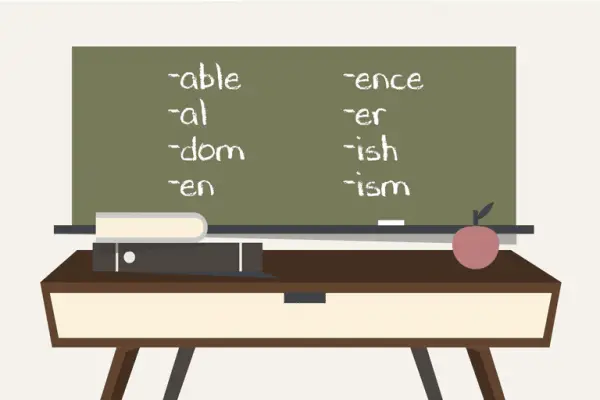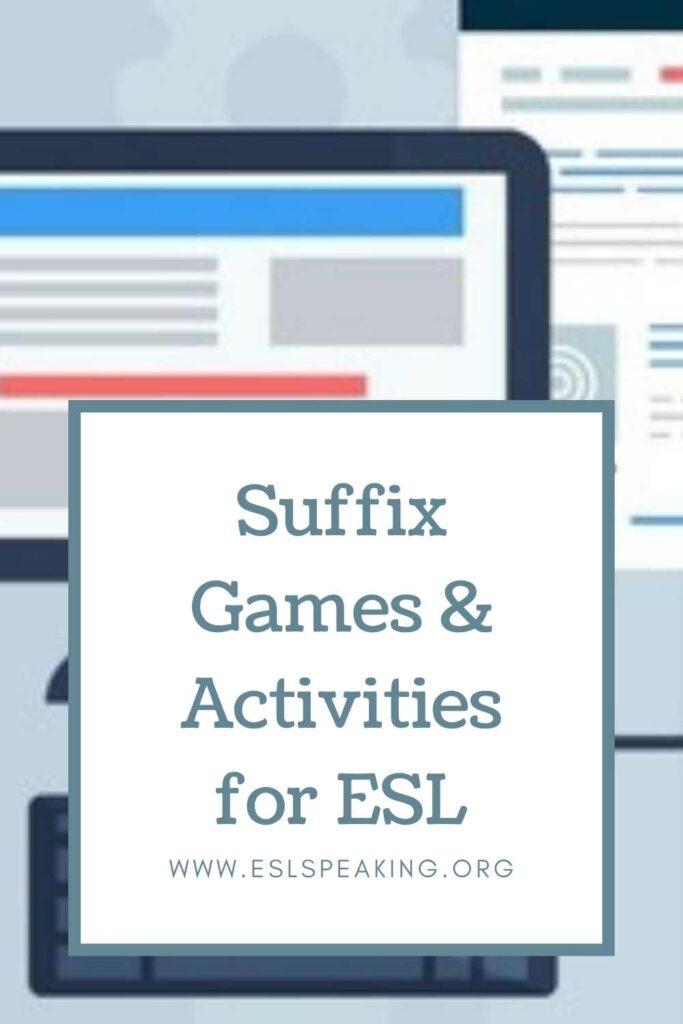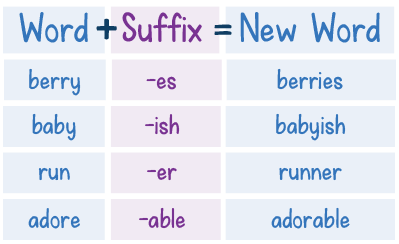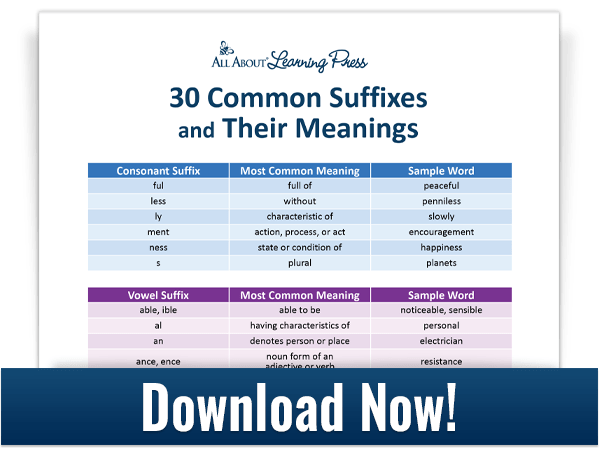Word formation is of crucial importance in language learning. It gives a chance to enrich the vocabulary with the help of already-known roots and words. In this article, we will discuss affixation (adding suffixes and prefixes to the root) as a great word formation tool.
1. It is important for learners to know how to form nouns, adjectives, verbs, and adverbs. If the teacher intends to devote the lesson to noun formation suffixes, he/she may prepare a poster activity with a chart of different noun formation suffixes.
Learners are given a pack of verbs and they need to classify these verbs according to the appropriate noun formation suffIx (e.g. move, friend, revise, appear). This is a very useful activity since the learners work in groups and they come up with the forms rather than being provided with them. See an example of the chart below.
The same activity can be applied while teaching adjective or verb formation suffixes or prefixes.
2. A maze, aimed at recapping suffixes and prefixes, is a great revision activity of word formation. Students try to exit the maze looking for words which follow the same word formation rules. The task might be the following:
- find the right path choosing adjectives whose opposites start with the prefix in-.
- find adjectives which form nouns by adding ance/ ity, etc
- find the words with the correct word formation.
Students are timed and it adds extra competition spirit into the activity.
See an example of the maze activity here.
3. 3. The teacher prepares two sets of word card: prefixes/suffixes and words that fit the chosen prefixes/suffixes to create new words. Students select one card from the Words pile and try to match it with the appropriate prefix /suffix to make a new word, note the new word down, put the Words card aside, and continue until they have no Words cards left. They can play individually/in pairs, in groups, against the clock or against each other to make as many correct words as possible.
The example provided here is targeted at revising noun suffixes -ment, -tion, and -sion.
Parts of Speech Bingo is an old but a tried-and-tested way of not only teaching but also revising word formation. Teacher selects words he/she intends the students to revise and prepares bingo cards. The game can be played either in this way when learners call out names of parts of speech (noun, verb, adjective, adverb), students cross out one word at a time (even if they have several nouns on their bingo card) or read out a sentence with a gap. Students who have the fitting word say it out loud and cross it out.
5. Students stand/sit in a circle, you (or any other student) select a category (word building suffix or prefix), students pass the ball around saying the words without repeating them and you monitor whether they are correct. The first person to say the wrong word/not say anything at all is eliminated (leaves the circle). The game goes on until there are two players left. Change suffixes/prefixes for each new round. It is a super engaging game and helps the learners dig deep to find a word which fits the category.
All these games are nice tools to help learners memorize word formation affixes. In order to reinforce the material, learners may be asked to come up with sentences where they need to use some of the given words, make up stories, ask questions to their partners. In this way, the knowledge of these words seems more purposeful to them and they enjoy this great way of expanding their vocabulary.
|
Subject: English |
Teacher: Koptleuova B. D. |
Date: 09/02/17 |
Grade: 6A |
|||||||||||||||||||||||||||||||||||||||||||
|
The theme: |
Word building suffixes |
|||||||||||||||||||||||||||||||||||||||||||||
|
The aim: |
||||||||||||||||||||||||||||||||||||||||||||||
|
Expecting results |
At the end of the lesson:
|
|||||||||||||||||||||||||||||||||||||||||||||
|
Visual aids |
presentation |
|||||||||||||||||||||||||||||||||||||||||||||
|
Method of the lesson |
Demonstration, question and answer, explain, conversation |
|||||||||||||||||||||||||||||||||||||||||||||
|
New 7 major components: |
“Use of ICT in Teaching and Training” Module Use group/pair works |
|||||||||||||||||||||||||||||||||||||||||||||
|
Plan of the lesson |
Teacher’s action Pupil’s action |
|||||||||||||||||||||||||||||||||||||||||||||
|
Organization moment |
Hello children! How are you? Who is on duty today? What date is it today? Who is absent? |
Hello teacher! We are fine! Duty’s answer for teacher’s questions |
||||||||||||||||||||||||||||||||||||||||||||
|
Checking up the home task |
What was your home task? Are you ready? Who wants to begin? Let’s check our homework.
|
Pupils should answer the question Check h/w |
||||||||||||||||||||||||||||||||||||||||||||
|
New theme: |
Pupils stand in a circle round and say good words to each other. Activity 1 Teacher introduces words in paper. Teach-teacher Invite — invitation Develop – development Sun-sunny Friend- friendly Danger –dangerous Care – careful Nation — national |
Pupils answer the teacher’s question |
||||||||||||||||||||||||||||||||||||||||||||
|
Checking up the understanding new theme |
Activity 2. Complete the chart
Activity 3. Complete the chart
Activity 4 Complete with the words
Activity 5 . Add suffixes and make sentences with them. Educate — Attend – Affect – Add – Write – Dance – Run |
|||||||||||||||||||||||||||||||||||||||||||||
|
Conclusion Reflection |
What have we done at the lesson? Did you understand the theme of the lesson? Have you any questions? If you liked and understand lesson, if lesson was interesting for you, draw sun, if you didn’t like the lesson draw cloud.
|
Pupils answer the teacher’s questions |
||||||||||||||||||||||||||||||||||||||||||||
|
Giving homework |
Your home task make sentences with words. |
Pupils write it in their diaries |
||||||||||||||||||||||||||||||||||||||||||||
|
Giving marks |
Good for you! All off you were active, but some pupils have mistakes. Your mark is…. |
Pupils give the diaries for mark |
||||||||||||||||||||||||||||||||||||||||||||
|
Summary evaluation What two things went really well (consider both teaching and learning)? 1: 2: What two things would have improved the lesson (consider both teaching and learning)? 1: 2: What have I learned from this lesson about the class or individuals that will inform my next lesson? |
This introductory lesson on suffixes is sure to get your young scholars excited about root word modification. Students will work both independently and in pairs as they work on a bunch of fun worksheets.
Grade
Subject
View aligned standards
Learning Objectives
Students will able to identify suffixes and their meanings and properly add them to root words.
- Ask students to discuss the definition of root word. Give them time to share their ideas, and then review the meaning and examples with them.
- Read aloud the Learning Objective and have students repeat it. Explain that students will be playing with words and different word parts today to figure out the meaning of new words they create.
Скачать материал
Скачать материал






Найдите материал к любому уроку, указав свой предмет (категорию), класс, учебник и тему:
6 210 159 материалов в базе
- Выберите категорию:
- Выберите учебник и тему
- Выберите класс:
-
Тип материала:
-
Все материалы
-
Статьи
-
Научные работы
-
Видеоуроки
-
Презентации
-
Конспекты
-
Тесты
-
Рабочие программы
-
Другие методич. материалы
-
Найти материалы
Другие материалы
- 05.11.2015
- 468
- 0
- 05.11.2015
- 519
- 0
- 05.11.2015
- 537
- 0
- 05.11.2015
- 2568
- 1
- 05.11.2015
- 548
- 1
Рейтинг:
5 из 5
- 05.11.2015
- 4712
- 19
Рейтинг:
5 из 5
- 05.11.2015
- 2577
- 22
Вам будут интересны эти курсы:
-
Курс повышения квалификации «Специфика преподавания испанского языка с учетом требований ФГОС»
-
Курс повышения квалификации «Специфика преподавания итальянского языка с учетом требований ФГОС»
-
Курс повышения квалификации «Специфика преподавания китайского языка с учетом требований ФГОС»
-
Курс профессиональной переподготовки «Теория и методика преподавания иностранных языков: английский, немецкий, французский»
-
Курс профессиональной переподготовки «Теория и методика преподавания иностранных языков в профессиональном образовании: английский, немецкий, французский»
-
Курс профессиональной переподготовки «Теория и методика преподавания иностранных языков в начальной школе»
-
Курс профессиональной переподготовки «Теория и методика билингвального обучения иностранным языкам»
-
Курс повышения квалификации «Организация кросс-культурной адаптации иностранных студентов в образовательных организациях в сфере профессионального образования»
-
Курс повышения квалификации «Специфика преподавания русского языка как иностранного»
-
Курс профессиональной переподготовки «Организация деятельности помощника-референта руководителя со знанием иностранных языков»
-
Скачать материал
-
05.11.2015
4109
-
DOCX
22.5 кбайт -
20
скачиваний -
Оцените материал:
-
-
Настоящий материал опубликован пользователем Суттибаева Маржан Абдрахмановна. Инфоурок является
информационным посредником и предоставляет пользователям возможность размещать на сайте
методические материалы. Всю ответственность за опубликованные материалы, содержащиеся в них
сведения, а также за соблюдение авторских прав несут пользователи, загрузившие материал на сайтЕсли Вы считаете, что материал нарушает авторские права либо по каким-то другим причинам должен быть удален с
сайта, Вы можете оставить жалобу на материал.Удалить материал
-
- На сайте: 7 лет и 11 месяцев
- Подписчики: 2
- Всего просмотров: 17396
-
Всего материалов:
5
A suffix is a part of a word that’s placed at the end of a base word and often transforms it into a new part of speech. Some of the most common suffixes include ed, ing, est. Check out our top recommendations for suffixes games and activities for ESL, along with worksheets, lesson plans and more.
Suffixes Activities
Are you ready to check out the best suffix games and activities? Then let’s get to it! Here’s how to teach suffixes in a fun way.
#1: Suffix Connect 4
You probably already know the game Connect 4, right? The goal is to get four in a row. But, you can also use it for English classes too.
Make up a board on a piece of paper with some base words that lend themselves well to suffixes being added. Or, you may want to limit it specifically to verbs that can be changed into nouns. Then, in order to get that square, a student has to use a suffix to make a new word. For more advanced level students, they may have to use that new word in a sentence.
The first student to get four in a row is the winner.
#2: Dictogloss Suffix Activity
A challenging activity that you can try out with your students is dictogloss. The way it works is that you can find (or write) a passage filled with lots of the target suffixes (past tense verbs with ed, or continuous verbs with ing for example).
Then, put student into pairs and read it out at a slightly faster pace than normal. They have to take notes as they’re listening and then work together to recreate what they hear, either by speaking or writing. Read it out again, slightly faster and students can add to what they already have.
Finally, they can compare with the original and then find all examples of the target suffix. Learn more about it here:
ESL Dictogloss Activity.
#3: ESL Suffix Videos
I sometimes think that my students get tired of hearing me talk! Maybe it’s the same for you? If that’s the case, you may want to consider some videos on YouTube. Sometimes I use the ones where it’s a teacher giving a lesson. Or, in other cases, people are having a conversation using the target vocabulary or grammar concept.
There are millions of videos on YouTube and a ton of ones that are specific to teaching English so you’re sure to find what you’re looking for.
#4: Hot Potato Game
I love to use the hot potato game when teaching kids because it’s fun and brings some energy and excitement into my classroom. The better news is that you can use it for teaching just about anything, including suffixes.
The way it works is that students pass around an object of some kind and when the timer or music goes off, the person holding it has to do something. In this case, students may have to make a sentence using a suffix after being shown a flashcard.
You can check out more details about this fun ESL game here: Hot Potato.
#5: Listening for One Specific Thing (Suffixes!)
In most ESL textbooks, suffixes are introduced through a reading or dialogue of some kind. However, you may also want to consider using a listening exercise. There are a ton of things you can do with them, but in this case, you may want to have students listen for one specific thing.
For example, students may have to listen for all the past tense verbs that end with ed. Or, the continuous verbs with ing. Check out some more ideas here: ESL Listening Activities.
#6: Suffix Songs and Chants
When teaching kids, you may want to consider bringing some songs and chants into your classroom. If you’re not musically inclined, we have some good news for you! There are a ton of great resources on YouTube so have a look around.
#7: Vocabulary Review Suffix Game
If your lesson is focused on a specific kind of suffix, then you may want to consider doing this flip-chart vocabulary review game. The way it works is that you can write a bunch of the target words on a flip-chart or big notebook of some kind.
The first team sends up a captain and you stand behind them. Then, you show the word to their team and they have to give hints to their captain who has to guess what it is. Find out all the details you need to know here:
English Vocabulary Review Game.
#8: Sufix Proofreading and Editing
It certainly is possible to make mistakes with suffixes, both in form and meaning. That’s why I like this proofreading/editing activity. Have a look here for all the details:
#9: The Memory Circle Suffix Activity
This is a fun memory game that can be used for almost any grammar point. The way it works is that the first student says a sentence with the target word (something with a suffix). Then, the second student says that first original sentence and adds their own.
The game continues until the last person is standing or time is up! Do you want to try it out? Learn more here: ESL Memory Circle.
#10: Flashcards Sufix Games
I love to use flashcards in my TEFL classes. They’re super versatile and can be used for a ton of activities. However, one of the simplest things you can do is show students a card and they have to make a word with a suffix and then spell it.
For example, if you’re working on the past tense with beginners, show them a card with a picture of someone doing something (jump). Then, they have to say “jumped” and spell out the word correctly.
Do you want to see some more ideas about how to use them in your classes? Check it out here: ESL Flashcard Activities.
#11: Suffix Vocabulary Auction
This activity is designed mostly for working on full sentence structure but can be easily adapted for suffixes. In this case, you’d want to have a nice mix of base words and then word endings. Students have to bid on ones they think can combine to make new words. Plus, you can have a trading time where students can interact with other teams.
Do you want to give this fun ESL game a go? See all the details here: ESL Vocabulary Auction.
#12: Flyswatter ESL Suffix Game
A fun way to review suffixes with your English learners is to write a bunch of them on the board. Then, divide the class into two teams and one student from each team comes up to the whiteboard and grabs a flyswatter.
Say the beginning of the word and the first student to slap an appropriate suffix that would fit with the word gets a chance to make a sentence. If correct, they get a point for their team.
#13: Suffix Board Game
In real life, I love to play board games which is why I like to use them in my classes too. They’re fun, interactive and student-centred and lend themselves well to any grammar point, including this one.
In this case, fill up the board with various suffixes. Then, when a student lands on that square, they have to make a word using that suffix and then use that word in a sentence. It’s challenging, fun and your students will love it! Learn how to make your own games:
ESL Board Games.
#14: Relay Race Game
#15: Guessing Suffix Game
This is a quick activity that I use for a variety of topics, including jobs, famous people, sports, foods, etc. It can also be used with words that end with a suffix.
Put a bunch of pictures on a PowerPoint slide that covers the target grammar or vocabulary. In this case, words that end with a suffix. Then, students have to take turns describing one of them to their partner who has to guess what their partner is describing. Try it out:
Guessing Game.
#16: Taboo Suffixes Game
I’m sure you’ve played the party game Taboo before. You have to describe a word without using a set of related words. It’s challenging, so I’ve adapted it for my English learners to make it slightly easier.
In this case, use words that end in a suffix and have students describe the words to the people in their group who have to guess what it is. Check it out:
ESL Taboo.
Suffix Games
How to Teach Suffixes
If you need a bit of a primer on English suffixes, worry no more! We have all the information you need to know in our easily digested guide.
3 Most Common Types of Suffixes
There are three common types of suffixes in English.
- S/ES which indicate plurals
- ED which indicates the past tense for regular verbs
- ING which is added to verbs in order to show that something is happening at the present time
Consonant vs Vowel Suffixes
In order to understand how to use a suffix correctly, students need to understand the difference between one that starts with a vowel and one that uses a consonant.
Some common consonant suffixes include: ly, ness, ful, ment, less.
Common vowel suffixes include: es, ing, ed, age, ish.
Rules for Adding Suffixes
There are a few rules to know about how to add a suffix to a word.
Add a consonant suffix directly to the word with no change. For example: limit + less = limitless.
You have to pay closer attention when adding a vowel suffix and check the base word carefully.
If the base word ends in two consonants, just add the suffix. For example: jump + ing = jumping.
It the base word has 1 syllable, 1 short vowel, and 1 final consonant, then double the final consonant. For example: win + ing = winning.
If the base word ends with a silent e, drop the e before adding the suffix. For example: smile + ing = smiling.
If the base words ends in a y and is more than one consonant, change the y to an. For example: crazy + ness = craziness.
Teaching Suffixes Worksheets
An easy way to make your life easier is to print off these worksheets when teaching suffixes instead of making your own! Seriously. It’ll save you a ton of time so why not, right? Here are some of our top picks:
ISL Collective
English Worksheets
ESL Galaxy
How to teach suffixes
Online Practice for Suffixes
If your students need some extra practice with this important vocabulary and grammar concept, direct them to the following online games, quizzes and practice exercises:
ESL Games Plus
English Grammar
ESL Sufixes Lesson Plans
Do you want some lesson plans that you can just print and use? Of course, all teachers do! It can be a huge time-saver to not have to plan lessons entirely from scratch. Here are some of our top recommendations for ESL suffix lesson plans:
Education.com
Study.com
BrainPop
FAQs for Sufix Games
There are a number of common questions that people have about teaching this grammatical point. Here are the answers to some of the most popular ones.
What are some examples of suffixes?
Here are some examples of suffixes:
- —ity, —ty (quality of, serenity)
- —ment (condition of, argument)
- —ness (state of being, sadness)
What are some common suffixes?
The most common suffixes are: tion, -ity, -er, -ness, -ism, -ment, -ant, -ship, -age, -ery.
How do you explain suffixes?
You can explain suffixes as a letter or group of letters that are added to the end of a word. They are used to show a part of speech, the verb tense or whether a word is singular or plural.
Did you Like these Suffixes Activities?
Yes? Thought so. Then you’re going to love this book over on Amazon: 39 ESL Vocabulary Activities for Teenagers and Adults. The key to better English classes is a variety of engaging, interesting and student-centred ESL activities and this book will help you do that in style.
You can get these vocab activities for ESL in both digital and print formats. Why not keep a copy on the bookshelf in your office to use as a handy reference guide when doing some lesson plans? Or, consider bringing the digital version with you to your favourite coffee shop on a phone or tablet for some lesson planning on the go.
Yes, it really is that easy to have English classes. Check out the book for yourself over on Amazon, but only if you want a serious dose of ESL teaching awesome in your life:
Have your Say about these Suffix Games and Activities
What do you think about these activities, worksheets and lesson plans for teaching suffixes? Did you try out some of the ideas from this list or do you have another recommendation for us? Leave a comment below and let us know what you think. We’d love to hear from you.
Also be sure to give this article a share on Twitter, Pinterest or Facebook. It’ll help other busy teachers, like yourself find this useful resource for teaching ESL suffixes.
Last update on 2022-10-15 / Affiliate links / Images from Amazon Product Advertising API
Welcome to our mini teaching guide on suffixes! In this post, you’ll find many different tools to help you teach suffixes to your child, as well as downloadable resources and activities. Let’s dig in!
What Is a Suffix?
A suffix is a word part that is placed at the end of a base word. Common suffixes include ED, ING, and EST. Take a look at more suffix examples below.
A suffix often transforms a word into a new part of speech. In the examples above, baby (a noun) is changed to babyish (an adjective); run (a verb) is changed to runner (a noun).
The Four Most Common Suffixes
The most common suffixes are S, ES, ED, and ING. These four suffixes are the most useful for beginning readers and spellers to learn because they appear frequently in words, and their meanings are easy to understand and remember.
Suffix S and ES indicate plurals.
Suffix ED indicates past tense.
Most often, suffix ING is added to verbs to indicate that something is happening in the present.
Interested in seeing more suffixes? Here’s a list of 30 common suffixes you can download and print.
Adding Suffixes Is Different from Adding Prefixes
When adding a prefix to a word (Check out our mini guide on teaching prefixes!), you simply add the prefix to the beginning of the base word (as in unhappy). The spelling of the base word never changes. Super easy, right?
But adding a suffix to a word isn’t quite as straightforward. That’s because when you add a suffix, the base word often changes. For example:
Thankfully, there are some solid guidelines to follow when adding suffixes to words. Before we dive into those rules, though, let’s take a quick look at the two types of suffixes.
Two Types of Suffixes
You may have noticed on the free download that the suffixes are divided into two categories.
It’s important for kids to recognize whether a suffix is a consonant suffix or a vowel suffix since the rules for adding them to base words are different.
Rules for Adding Suffixes
Rule 1: Add a consonant suffix directly to the base word.
Rule 2: Check the base word before adding a vowel suffix.
Here are the first three guidelines we teach for adding vowel suffixes.
- If the base word ends in two consonants, just add the vowel suffix.
- If the base word has 1 syllable, 1 short vowel, and 1 final consonant, double the final consonant before adding the vowel suffix. (We teach this as the “1-1-1 Rule.” Although it may sound complicated, this rule is actually quite easy to follow when you have an understanding of syllable division rules.)
- If the base word ends in a Silent E , drop the E before adding the vowel suffix. (Again, this is an easy rule to understand: you don’t want to have two E’s in a row, so you have to drop the first E.)
Rule 3: If the base word ends in a single Y, change the Y to an I before adding the suffix.
(This rule applies to both consonant suffixes and vowel suffixes.)
There are more rules regarding vowel suffixes, but they apply to a smaller number of words. We teach them thoroughly and incrementally in All About Reading and All About Spelling, with plenty of hands-on practice.
What does hands-on practice look like? We use letter tiles for demonstration, and then we move on to interesting activity sheets!
Printable Activities for Learning about Suffixes
Would you like to see some examples? Here are a few great suffix activities from All About Reading and All About Spelling.
Have you started teaching suffixes to your child yet? How is it going? Let me know in the comments below!
Subject: ELA- Reading
Grade: 3
Lesson Objective: To learn about common suffixes and demonstrate an understanding of them
Common Core Standard: CCSS.ELA-LITERACY.RF.3.3.B- Decode words with common Latin suffixes.
Materials:
- Printable Student Handout Worksheet
Starter:
Say:
- What is the difference between the words end and endless? (Allow the students to answer.)
Main:
Say:
- The word end means that there is something that stops eventually. The word endless means that there is no end or the thing does not ever stop.
- Behind the word end are the letters “less.” “Less” is a suffix.
- A suffix is a word or a group of letters that change the meaning of a word.
- There are many different suffixes. We are going to talk about 4 of those suffixes today.
- The suffixes that we are going to talk about are -er, -ly, -ful and -less. (Write the prefixes on the board and point to them as you talk about them.)
- The suffix -er is a way to compare something. For example, if you have the word small and then add an -er to the end, the word is smaller, which means littler.
- The suffix -ly changes the meaning of the word to a characteristic, or a way to describe something. For example, using the word beautiful, when you add an -ly to the end, the word is beautifully. This means that something was done in a very pretty way.
- The suffix -ful means full of. The word painful means something that is full of pain.
- The suffix -less means without. The word painless means something without pain.
- Now, you are going to be doing a worksheet so that you can practice what you learned about suffixes. You will see the suffix and then two words with a blank next to each. Figure out which word works best with the suffix. Then, add the suffix to that word by writing the word with the suffix on the line.
- Does anyone have any questions?
Feedback:
Say:
- Who would like to share their answers? (Allow the students to share and go over the answers.)
Written by Kimberly Greacen, Education World® Contributing Writer
Kimberly is an educator with extensive experience in curriculum writing and developing instructional materials to align with Common Core State Standards and Bloom’s Taxonomy.
Copyright© 2019 Education World
Common English Words And A Suffix
Today we talk about English words using a suffix or prefix. We discuss how to spot them in use, how to use them and what they mean. To help explain things, we take a common suffix and explain how to apply it with lots of examples. As usual with the English language, there are some special grammar rules, so we also explain these special cases.
So as I publish today’s English lesson and I read some common English words from today’s lesson transcript, “Fearful” and “Fearless”, it made me think of what is happening in the UK today.
It’s a strange day here in the UK, as children are returning to school. Having been away for so long, over 6 months now, there is a lot of anxiety. A lot of new rules about wearing masks and keeping your distance. I guess a lot of unknowns. We all knew it had to happen at some point, but knowing that is not really helping. A parent being fearful.
The COVID-19 world is on its way back to the 1800’s, when people were fearful of germs and viruses.
⭐ Steven Magee, Author
So you can imagine my surprise this morning to discover my son up early taking a shower, all excited to get out of the house and meet up with his friends. Not a worry in the world, just keen to get back to his social circle. A child being fearless.
Most Unusual Words:
Guessable
Ahh
Most common 5 word phrases:
| Phrase | Count |
|---|---|
| Let’s do a bit of | 2 |
| You may not realise the | 2 |
| So back to our list | 2 |
| That’s ‘less’ on its own | 2 |
Listen To The Audio Lesson Now
The mp3 audio and pdf transcript for this lesson is now part of the Adept English back catalogue . You can still download and listen to this lesson as part of one of our podcast bundles.
Transcript: Using A Suffix With Common English Words
Hi and welcome to Adept English.
Let’s do a bit of Rule Six of Adept English today. If you listen to our free course, the Seven Rules of Adept English, you’ll hear about Rule Six, which we call ‘the helping hand’. This means that we give particular attention to parts of the English language, to give you shortcuts, realisations, things which suddenly make sense to you. You might say ‘Ahh! I get this now. I understand it now’.
What are suffixes?
So today, let’s do a bit of work on suffixes. A suffix, S-U-F-F-I-X is attached to the end of a word and a prefix, P-R-E-F-I-X is attached to the beginning of a word. So lots of words in English make use of prefixes and suffixes. And if you meet these words individually, you may not realise the connection, you may not realise the meaning of a particular suffix or prefix. But if you do know the meaning of the prefix or suffix, even a word you’ve not seen before is more guessable.
Video
Suffixes – list of example words
So today, let’s take a few words with a particular suffix and look at the meanings and therefore work out what the overall meaning of the suffix is. What about these words with the same word ending?
- Homeless
- Meaningless
- Spotless
- Mindless
- Hopeless
- Endless
- Fearless
Explanation of the word ‘less’
Well, first of all, they’re all adjectives, they’re all describing words. But they also all end in -L-E-S-S, ‘less’. So what about the word ‘less’ on its own? It can be used as a determiner, a pronoun or an adverb and it means ‘a smaller amount of’ something.
So ‘less’ as a determiner, you might say ‘I now take less sugar in my tea’ or you might say ‘I’ve now got less work than I had before’. So that’s as a determiner. As a pronoun, you might say ‘College work? I’ve done less this year’. So there it’s substituting for a noun. And as an adverb, so describing a verb, you might say ‘My foot is hurting less now’. So that’s ‘less’ on its own.
A bee in Hilary’s bonnet
But just a quick word about ‘less’ – if you’re using it as a determiner – so like where you say ‘less sugar’ or ‘less work’, that’s fine with uncountable nouns. Those are the nouns like ‘traffic’ or ‘custard’. So with countable nouns, like cars or apples or dogs, you can’t use ‘less’, You must say ‘fewer’, F-E-W-E-R instead.
So you can remember this by thinking about ‘less traffic’, ‘less custard’, ‘less sugar’, ‘less work’, but ‘fewer dogs’, ‘fewer cars’, ‘fewer apples’. I have what you could call ‘a bee in my bonnet’ about this one – English speakers get it wrong all the time! But anyway, that’s ‘less’ on its own.
‘Less’ as a suffix
So back to our list of words. Knowing what less means now – you can perhaps guess the meanings of each of those words more easily. So ‘homeless’ means ‘without a home’ And indeed ‘homelessness’ is a problem in the UK especially in London, even though we’re a relatively rich country. So notice another suffix there, ‘homelessness’, N-E-S-S on the end.
Words ending ‘ness’ tend to indicate a ‘state of being’, like ‘sadness’ or ‘happiness’. So back to the suffix ‘less’. So ‘homeless’ means ‘without a home’, ‘meaningless’ means ‘without meaning’. So if your work, your job isn’t very satisfying, it may feel ‘meaningless’. Or if you’re criticising a book that you don’t like, you might say ‘it’s meaningless’, it’s none sense, it has no meaning. ‘Mindless’, means ‘without mind’, so we could talk about ‘mindless violence’ – violence that’s been done to a person or a thing, without there seeming to be any thought or reason behind it. ‘Endless’, means seemingly ‘without end’.
We use ‘endless’ sometimes even where clearly there is actually an end, but it might feel good to exaggerate! So you could say ‘She talked endlessly about her boyfriend’. Actually, her conversation must have come to an end at some point because we all go to bed at night, but perhaps it didn’t feel as though it would ever end! ‘It was endless!’ And ‘hopeless’ means ‘without hope’. And ‘fearless’ means of course ‘without fear’.
‘Spotless’ is slightly different. Taken logically, it means ‘without spots’, but the way we use this is when we’re talking about how clean, C-L-E-A-N something is. So to emphasise ‘very clean’, we might say ‘spotless’. So you could hear ‘the hotel room was spotlessly clean’ or ‘the bed sheets hanging on the washing line were spotless’.
Would you like 250 Adept English podcasts on your phone?
Just pausing a minute there to check whether you’re enjoying this podcast and whether you’re finding it useful? If you are and you’d like access to further podcasts, you will find many more like this, either on the platform you’re listening to or on our website.
Boost Your Learning With Adept English

But if you’ve already heard the podcasts that are available, there are still some more to listen to. In fact, there are another 250 podcasts, which you can buy in groups of 50 or you can buy the whole 250 podcasts all in one go. This is a great resource to have on your phone, so that you can do your English language listening practice at any time. Have a look on our website, under ‘Courses’ and you’ll find the podcast bundles there, ready for immediate download.
Suffixes – from ‘less’ to ‘ful’?
So back to our list again. Homeless, meaningless, spotless, mindless, hopeless, endless and fearless. You could take these same words and add the suffix ‘ful’, F-U-L on the end. ‘Ful’, FUL isn’t a word in its own right – but F-U-L-L is – and that’s the meaning of the suffix ‘ful’.
So whereas the suffix ‘less’ means ‘without’, the suffix ‘ful’ means ‘full of’. So swapping a ‘less’ suffix for an ‘ful’ suffix works for some words, but not others. So you can say ‘homeless’, but you can’t say ‘homeful’. You also can’t make ‘spotless’ into ‘spotful’, and you can’t make ‘endless’ into ‘endful’.
Download The Podcast Audio & Transcript
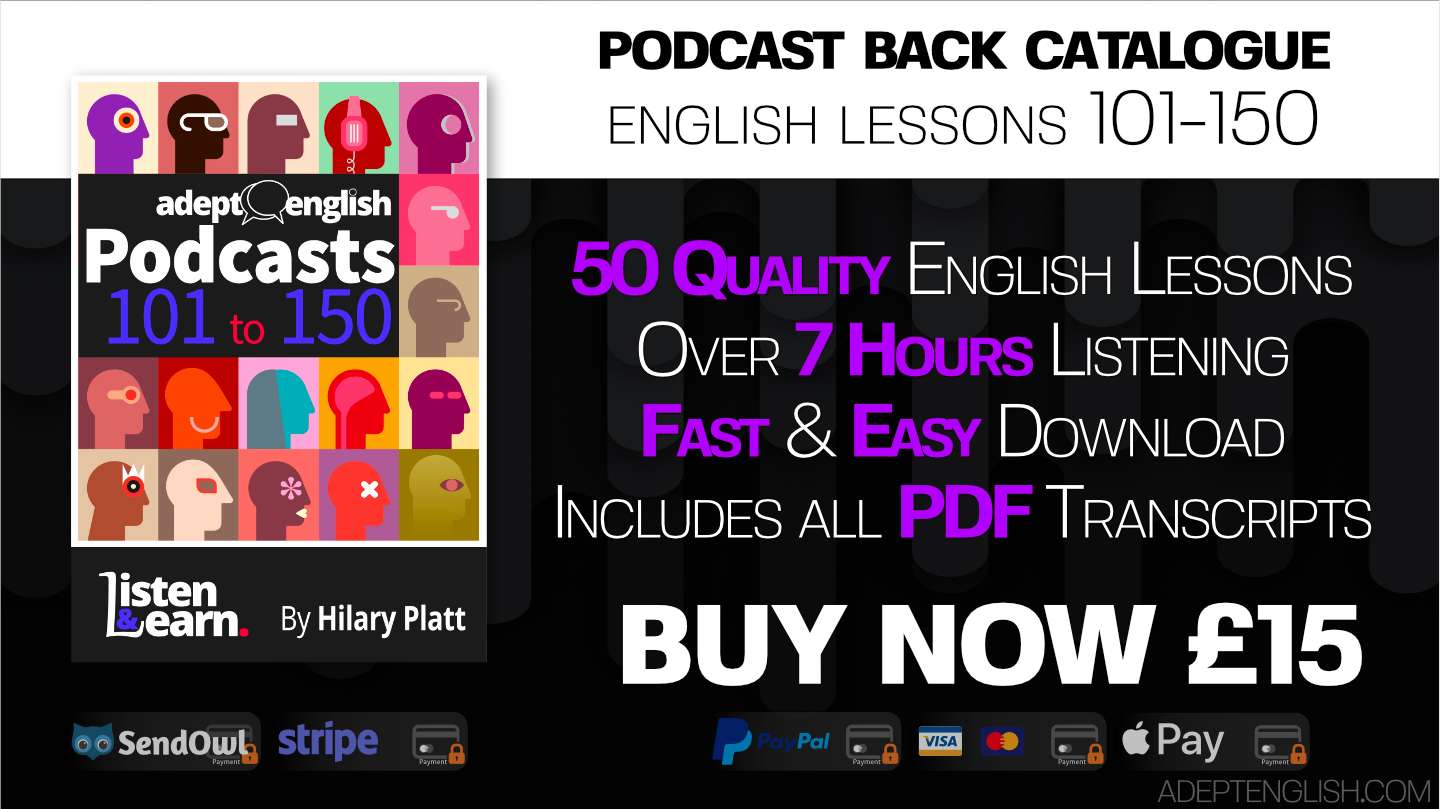
Those don’t work! But ‘meaningless’ and ‘meaningful’, ‘mindless’ and ‘mindful’, ‘hopeless’ and hopeful’ and ‘fearless’ and ‘fearful’ – they all work. They’re all words with opposite meanings.
Phrases to test your understanding – with a challenge question!
Here are some more phrases with ‘less’ words in them – words with the suffix L-E-S-S. I’ll leave you to work out the meanings of these phrases.
- Expressionless faces
- Characterless houses
- Emotionless logic
- Motherless children
- Seamless leggings
- Painless dentistry
- Timeless style
- Priceless antiques.
There are many more words with an L-E-S-S suffix, but at least now you’ll know how to look at the first bit of the word to see what it that’s being described as missing! And here’s a challenge for you – just in case this podcast is easy! Only two of the words I’ve just listed can have the ‘less’ suffix replaced by the F-U-L suffix and make a valid word. Can you tell which ones they are? The answers are in the transcript.
Goodbye
Enough for now. Have a lovely day. Speak to you again soon. Goodbye.
Links
- Other Suffixes
- More on Suffix and Prefix
- Other common word articles
- 7 Rules Of Adept English
- FREE English language course
- Spotify
- Apple
- Podcast bundles








